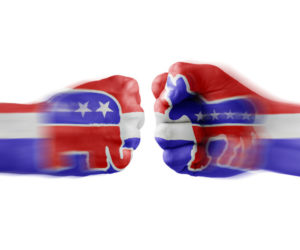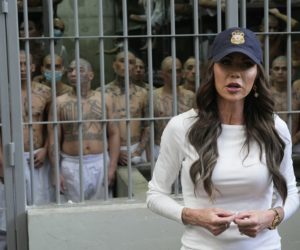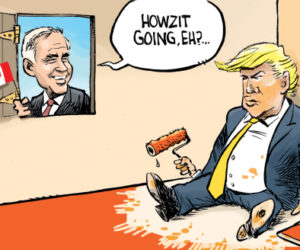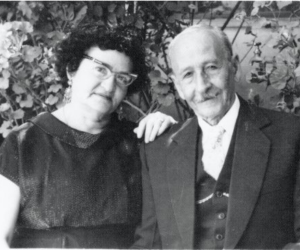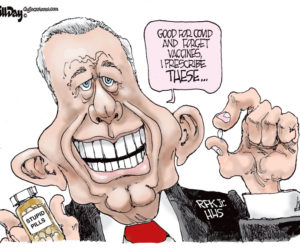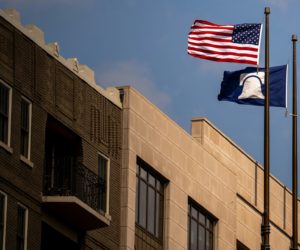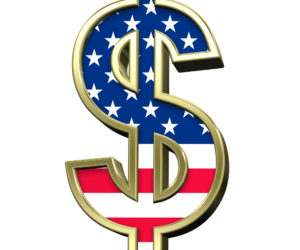Historic Tidbit: During the height of Watergate, Dan Rather asked a rather pointed question of Nixon, prompting the President to ask Rather if “he was running for something.” Rather then replied, “No sir, Mr. President. Are you?”
Throughout the Bush Presidency, Dick Cheney joked several times that he had “delivered” the state of Wyoming’s three electoral votes to the ticket. He joked that while Wyoming was among the most safely Republican states in the nation, every state proved crucial in allowing Bush/Cheney to clear the 270 vote mark. But at one time, Wyoming was a critical state for helping to pick the next
President — at the convention. It was 1960 and John K. Kennedy was 4 votes shy of going over the top to receive his party’s nomination in Los Angeles. Wyoming had 15 delegates. And Ted Kennedy was in the forefront.
For in 1960, Wyoming’s Democratic Party was vibrant. It had a Democratic Governor, John “J.J” Hickey, and two Democratic Senators, Joe O’Mahoney and Gale McGee. McGee the Senator is covered extensively in a previous chapter involving Frank Church and Frank Moss, but his role in putting Kennedy over the top cannot be understated. McGee initially backed Lyndon Johnson in ’60 and it was not difficult to understand why. McGee had won his Senate seat barely a year before and LBJ was his Majority Leader, and a powerful one at that. But as it became clear that the nomination would be more and more up for grabs, McGee became neutral. Never in his wildest dreams could he have mentioned the enormity that would mean to a single moment as the convention roll call approached Wyoming on the first ballot.
At that point, JFK was 11 votes shy of clinching the nomination. Eight and 1/2 were committed to him, while Johnson controlled six and Stevenson had half a vote (convention lingo). Ted Kennedy knew how to add and planted himself firmly in the middle of the Wyoming delegation at the convention hall. When Wyoming was called, a voice was heard from the top of the chair yelling, “Give me four votes! We can put him over the top! Please give me four votes!” Johnson forces, who had been hoping to force Kennedy into a second ballot, tried to grab the microphone, but the delegates exceeded to their man’s request. Wyoming’s Democratic Chair said the words, “Wyoming casts all 15 of its votes for the next President of the United States….” Kennedy was the pick.

JFK with Hickey, his successor Jack Gage, and Wyoming Eagle editor Tracy McCracken(Wyoming Almanac)
That Wyoming Chair was Teno Roncalio, who would go on to win a House seat and would ultimately become the last Democrat to hold federal office from Wyoming. He recalls “In the roar greeting the announcement, I kept my eyes on the man who had begged for four votes. He was jumping up and down, slapping a beaming Ted Kennedy on the back, apparently beside himself with joy. I recognized him as our old friend Senator Gale McGee.”The convention roared. The young Senator from Massachusetts, younger than McGee and Roncalio, would now carry the torch for their party in November. And they had Wyoming to thank, which is why McGee and Roncalio are true footnotes to history. And the characters I will cover also show the small degrees of separation in such a small state.
Kennedy had campaigned for the Democratic ticket in 1958, when their odds for success had seemed uphill. McGee was challenging incumbent Frank Barrett for the Senate and Hickey was taking on Milward Simpson for Governor. Simpson was the father of the future Senator Alan Simpson.
Hickey hailed from Carbon County and was forced to take odd jobs to put his way through school (his father had died when Hickey was three). Hickey’s first brush with fame came when he was plucked by Harry Truman in 1949 to serve as a United States District Attorney.
His win against Simpson was unexpected, and narrow. Hickey was not someone who was forceful, and often was described as “quiet and unassuming who talks in a low voice. At gatherings, he’ll stand along the sidelines talking with small groups.”
In many ways, the election blurred party lines, certainly by today’s standards. A New History of Wyoming notes Simpson was against capital punishment, an issue that resonated due to a series of murders that had occurred throughout the state. and Hickey for. But Wyoming observers credit Simpson’s codification of a “non-partisan” highway commissions recommendation that the Interstate highway intersection would go through Buffalo. The New History of Wyoming says “he angered Sheridan County voters who sat out the fall election.” Simpson, who according to T.A. Larson’s History of Wyoming had taken Sheridan by 741 votes in his ’54 election, this time lost to Hickey by 1,708 vote.Simpson also was unpopular for wanting the state to purchase the concessions from Yellowstone, which he felt Wyoming was not getting it’s fair share, causing him to lose ground in Teton County as well.
Meanwhile, Hickey campaigned against the “interference” by the federal government and won the election by 2,582 votes. He was said to be so surprised by his win that he “apologized” to Simpson on their congratulatory call.
Hickey’s Governorship was a mixed bag. Larson notes he tried to reduce the budget proposal to $30 million, about $5 million less than what the Legislature wanted, but they restored about $3 million of it. Because legislators would not give him a severance tax, he could “not deliver” on a pledge to restore Homestead exemptions. He worked out a plan to allow the state to accept federal aid for the Board of Education. He advocated the creation of a “little cabinet” to centralize state government. And Larson notes that he and legislators “became very much excited about state’s rights with regard to choice of color used in painting stripes on federal aid highways.” But he was not a favorite of his own party. State officials were quoted as saying they “can’t believe he’s a Democrat. He’s more conservative than most Republicans.”
 width=”192″ height=”159″ class=”alignnone size-full wp-image-183074″ />
width=”192″ height=”159″ class=”alignnone size-full wp-image-183074″ />
McGee, O’Mahoney, and Carl Hayden of Arizona, 1958 (uwyo.edu)
Meanwhile, O’Mahoney was the elder statesman of the bunch and in many ways may have been the last national politician from the state to be a true national Democrat. O’Mahoney had been appointed Assistant Postmaster by James Farley early in the Roosevelt administration, but he would soon go on to something better. Late in 1933, Democratic Senator Kendrick died and O’Mahoney was appointed to fill the seat.
In the first FDR midterm, he had no trouble securing a full term. And he was a true champion of Roosevelt. About the only issue he opposed him on was his “court-packing” plan. O’Mahoney helped push through the Temporary Economic Committee, which he chaired. But he also played close attention to Wyoming issues, chairing the Committee on Indian Affairs and eventually, the committee on Interior Affairs. He was a dogged advocate of Wyoming industry.
O’Mahoney won two re-elections since ’34, including one over Simpson, and by ’52, seemed poised to do so again. But the Eisenhower landslide, which delivered Congress to the Republicans, was enough to knock him out 52-48%. However, O’Mahoney, nearing 70, did manage to get a rare second act a little over a year later. In 1954, the state’s other Senator, Democrat Lester Hunt, committed suicide and O’Mahoney was appointed to take his place. 1954 proved to be a much more favorable Democratic year and at 70, O’Mahoney won a six year term to serve in the Senate where he became instrumental in passage of the 1957 Civil Rights Act. He also took on the corporations, wanting “concentrated industries” to provide notice and explanations for rate increases.
In 1959, O’Mahoney, 75, suffered a stroke, which basically set in stone a decision not to seek re-election in 1960. Wayne Morse, who wheeled him onto the floor for his farewell, called him among the most “able and effective” at fairness issues. He died two years later at 78.
Republican Congressman Keith Thomson, 41, won the election to succeed O’Mahoney and seemed headed for a long career. But he dropped dead of a heart attack at his Cody ranch just two weeks later. Hickey had the power to appoint the new Senator. And he decided that he knew just who he wanted that to be: himself. Hickey resigned the Governorship in January of 1961, just a day before the new Senator would have to take office in order to be on parity seniority wise with other Senator’s from that class.
Hickey said it had been his intention to appoint Tracy McCraken, a well-known entrepreneur and owner of the “Wyoming Eagle” in the state to fill the seat, but he himself had died of a heart attack that December. So upon resigning the Governorship, Hickey made an arrangement for his successor, Jack Gage, to appoint him to the seat. That immediately brought howls from Wyomingites of many stripes. Hickey, noting that the appointment would be short term, noted that voters would have the ultimate say in whether he kept the seat. “If I do the job I want to do,” he said, “I will certainly be a candidate.”
Ultimately, the voters did decide and it was not the verdict that Hickey had hoped for. By the time November of 1962 rolled around, Wyoming was the one Senate seat Democrats held that knew they would not salvage. And he’d lose the election to fill the remaining four years of his term by a lopsided 58-42%. Who unseated him? Milward Simpson, returning the favor of four years earlier. Hickey became a Circuit Judge but himself died young in 1970, at just 59. Hickey’s son would seek the Governorship in 2002, but would lose the Democratic primary to Dave Freudenthal.
McGee continued in the Senate until his loss to Malcolm Wallop in 1976, one of the first signs of the forthcoming rise of the “New Right”
Meanwhile, Roncalio, the eighth of nine children of Italian immigrants, won a House seat in the Johnson year of 1964, defeating William Henry Harrison, grandon of the 23’rd President and great-grandson of the 9th. He’d say, “I went from bootblack to banker.”
Roncalio had a tightrope to walk representing a state that was only getting more conservative as time went on, but did so without signs of bother. He backed Civil Rights and Medicare but locally, fought for the Washakie wilderness area and the Trans-Alaska Pipeline. He also stopped “Project Wagonwheel,” a plan to build five nuclear devices to release gas from the rocks. On his death, State Senator Jayne Mockler called him, “one of the most genuine people I have ever met. He was one of the most genuinely sincere political figures in the state, and he did it for all the right reasons. “The true measure of the man is that 25 years after he retired from an active political life, we still remember what he did.”
“He did it for the people, he did it to help move the state forward, and there didn’t seem to be a lot of personal self-motivation.” Even the state Republican Chair said he “loved Wyoming.”
“The true measure of the man is that 25 years after he retired from an active political life, we still remember what he did.”
Roncalio thought he could parlay his success into a U.S. Senate seat in ’66 and came surprisingly close. But Republican Governor Cliff Hansen, himself considered among the most genuine individuals in politics, edged him 52-48%. Roncalio won the seat back by 608 votes in 1970 and, perhaps scared by McGee’s defeat and his own close scrape in ’76, retired in 1978. A guy by the name of Dick Cheney succeeded him. Though several have come close, no Democrat has won a federal office since.
A one-time employee, Kathy Karpan, a former Secretary of State who had herself run for Governor and the Senate, seemed to note that by calling Roncalio, the last Wyoming representative to Congress who was able to advocate for the environmental and energy agendas.” He died at 87 in 2003.
 width=”300″ height=”200″ class=”alignnone size-medium wp-image-183080″ />
width=”300″ height=”200″ class=”alignnone size-medium wp-image-183080″ />
Roncalio with William Henry Harrison, Simpson, Hansen, and FDR JR (Wiki Photo)
And as for Kennedy. He of course narrowly won the Presidency in November, but Wyoming had nothing to do with it. Nixon carried the state 55-45%. Grateful for the state’s role in putting him over the top, he would visit Wyoming once again in September of 1963, this time as President. He stopped in Cheyenne, and the 10,000 folk crowd that greeted him was said to have been the largest ever assembled for a gathering in the state. Two months later, he was dead. But Wyoming’s legacy lives on in his, and America’s history.



